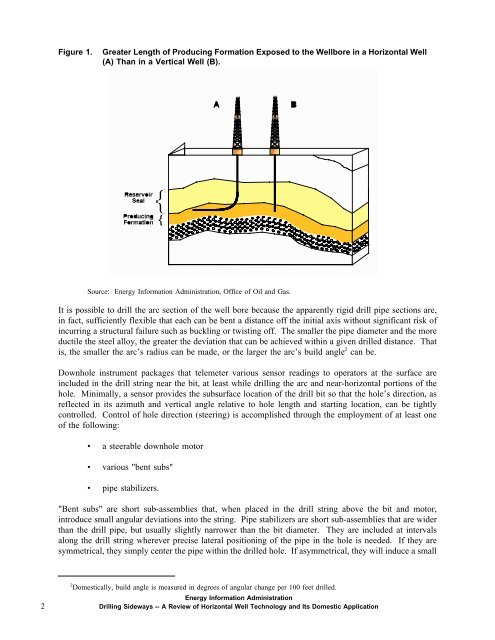Drilling Sideways -- A Review of Horizontal Well Technology ... - EIA
Drilling Sideways -- A Review of Horizontal Well Technology ... - EIA
Drilling Sideways -- A Review of Horizontal Well Technology ... - EIA
Create successful ePaper yourself
Turn your PDF publications into a flip-book with our unique Google optimized e-Paper software.
Figure 1. Greater Length <strong>of</strong> Producing Formation Exposed to the <strong>Well</strong>bore in a <strong>Horizontal</strong> <strong>Well</strong><br />
(A) Than in a Vertical <strong>Well</strong> (B).<br />
Source: Energy Information Administration, Office <strong>of</strong> Oil and Gas.<br />
It is possible to drill the arc section <strong>of</strong> the well bore because the apparently rigid drill pipe sections are,<br />
in fact, sufficiently flexible that each can be bent a distance <strong>of</strong>f the initial axis without significant risk <strong>of</strong><br />
incurring a structural failure such as buckling or twisting <strong>of</strong>f. The smaller the pipe diameter and the more<br />
ductile the steel alloy, the greater the deviation that can be achieved within a given drilled distance. That<br />
is, the smaller the arc’s radius can be made, or the larger the arc’s build angle 2 can be.<br />
Downhole instrument packages that telemeter various sensor readings to operators at the surface are<br />
included in the drill string near the bit, at least while drilling the arc and near-horizontal portions <strong>of</strong> the<br />
hole. Minimally, a sensor provides the subsurface location <strong>of</strong> the drill bit so that the hole’s direction, as<br />
reflected in its azimuth and vertical angle relative to hole length and starting location, can be tightly<br />
controlled. Control <strong>of</strong> hole direction (steering) is accomplished through the employment <strong>of</strong> at least one<br />
<strong>of</strong> the following:<br />
• a steerable downhole motor<br />
• various "bent subs"<br />
• pipe stabilizers.<br />
"Bent subs" are short sub-assemblies that, when placed in the drill string above the bit and motor,<br />
introduce small angular deviations into the string. Pipe stabilizers are short sub-assemblies that are wider<br />
than the drill pipe, but usually slightly narrower than the bit diameter. They are included at intervals<br />
along the drill string wherever precise lateral positioning <strong>of</strong> the pipe in the hole is needed. If they are<br />
symmetrical, they simply center the pipe within the drilled hole. If asymmetrical, they will induce a small<br />
2 Domestically, build angle is measured in degrees <strong>of</strong> angular change per 100 feet drilled.<br />
Energy Information Administration<br />
2 <strong>Drilling</strong> <strong>Sideways</strong> -- A <strong>Review</strong> <strong>of</strong> <strong>Horizontal</strong> <strong>Well</strong> <strong>Technology</strong> and Its Domestic Application

















